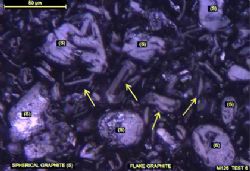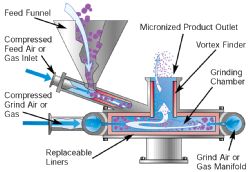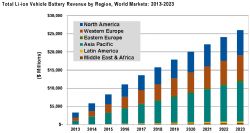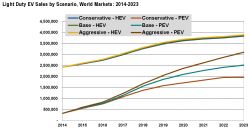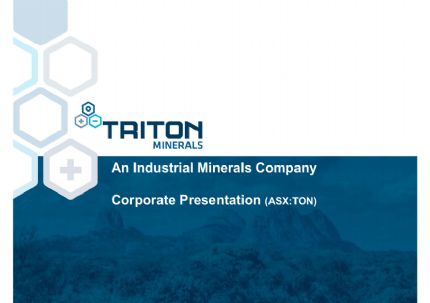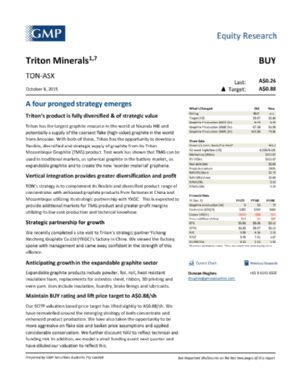
Battery Grade Spherical Graphite Produced
Perth, Aug 20, 2015 AEST (ABN Newswire) - Triton Minerals Limited ( ASX:TON) (Triton or Company) is very pleased to advise that initial laboratory tests confirmed the production of spherical graphite from Nicanda Hill graphite concentrate.
ASX:TON) (Triton or Company) is very pleased to advise that initial laboratory tests confirmed the production of spherical graphite from Nicanda Hill graphite concentrate.
Spherical Graphite
- High quality battery grade spherical graphite produced from Nicanda Hill graphite.
- Triton positioned to supply to multi-billion dollar battery sector.
- Spherical graphite ideally suited for lithium ion batteries and energy storage applications.
- TMG product range expanded.
- Further optimisation work is ongoing.
Triton's Managing Director & CEO Brad Boyle said: "These tests confirm that Nicanda Hill graphite is ideally suited for the creation of the high value spherical graphite which is the foundation for the energy storage and electric vehicles markets.
The battery market is an exciting, high growth sector. Triton will investigate incorporating spherical graphite production into future processing operations."
Triton confirms initial tests undertaken on typical Nicanda Hill flake graphite concentrate by a highly reputed American-based laboratory, using jet milling (spheroidisation) equipment, has successfully produced spherical graphite (Figure 1 in link below).
Results to date are considered very encouraging and further testing will continue to optimise performance and recoveries rates.
Spherical graphite has the potential to substantially increase the range of TMG products and to enhance the future revenue stream of the Company. Triton will now review the additional options available and consider the benefits of incorporating a scaled production process of spherical graphite into future product streams.
Nicanda Hill flake graphite concentrate was utilised in the initial tests due to the presence of the naturally occurring high purity finer flake material. The benefits of using this naturally-occurring material directly, is the reduction in the time and costs required to grind the concentrate particles to the required size.
The initial milling tests (using a patented process (Figure 2 in link below) was applied to a sample of Nicanda Hill flake graphite concentrate with an average feed size of less than 100 microns (-140 mesh). The Company considers the outcomes of this initial test to be very positive with the successful production of a wide range of spherical graphite particles ranging from 5 to 40 microns.
The spherical graphite industry utilises a standard deviation system for classifying particle distribution and they have found that the smaller spherical graphite particle size will create a larger surface area which has a higher density and will increase storage capacity potential of the graphite particle.
Triton confirms the spherical graphite produced in these initial limited tests consisted of an average of 90% distribution at <35 microns, 50% distribution at <13 microns and 10% distribution at <4.5 microns. The spherical graphite was produced by patented air powered jet milling equipment.
Research has found the spherical graphite particle size for Li-ion batteries are split into two main categories. The Li-ion course sizing battery requires spherical graphite with particle sizes ranging from 25 microns to 48 microns, whilst the fine sizing battery requires spherical graphite with particle sizes ranging from 3 microns to 25 microns. Therefore, these initial tests demonstrate Triton's Nicanda Hill graphite is ideally suited for the creation of the spherical graphite and use both categories of the ever growing Li-ion battery market.
LITHIUM ION BATTERIES
The battery market is a rapidly growing sector with demand forecast to grow at approximately 9% per annum based on the growth forecasts in the lithium ion battery demand (Source: Industrial Minerals), which is being driven mainly by the growth in hybrid and electric cars such as the Toyota Prius, BYD and Tesla.
Industrial Minerals Magazine and Benchmark Mineral Intelligence estimate that approximately 90% of spherical graphite produced around the world is used in batteries. It is estimated 60,000 tonnes per year of graphite is consumed in the manufacture of anodes for Lithium Ion Batteries (consisting of approximately 35,000 tonnes of natural graphite and 25,000 tonnes of synthetic graphite).
There is approximately 10 times more graphite than lithium required in a lithium ion battery. Traditionally spherical graphite has been made from artificial graphite because of its high quality and purity. The downside is synthetic graphite is made from a by-product of refining oil and is an energy intensive and expensive process may not necessarily be environmentally sustainable.
Triton is able to produce high purity and quality flake graphite from Nicanda Hill at a fraction of the cost to produce the artificial graphite, which makes Nicanda Hill natural graphite a far more cost effective option in the production high quality spherical graphite for batteries.
Recent reports show that many of the global automotive manufacturers are accelerating their efforts to produce more vehicles utilising electric engines (Source: Navigant Resource). The rapid growth in this sector is being influence by many factors including fuel economy standards, greater confidence in electric-powered vehicles, and major advances in battery technology.
One of the key influences in the sector has been the launch of the Toyota Plug-in Prius in 2012, which was powered for the first time with lithium ion (Li-ion) batteries. Since then, most of the other major automotive manufacturers have introduced battery electric vehicle (BEV) and plug-in hybrid electric vehicle (PHEV) models, almost all of which use Li-ion batteries for on-board energy storage.
As improvements continue with Li-ion batteries in light duty consumer vehicles is estimated this sector will grow from $3.2 billion in 2013 to $24.1 billion in 2023 as seen in Figure 3 in link below (Source: Navigant Resource) and Triton is perfectly situated to take advantage of this growth sector by producing cost effective high quality natural spherical graphite.
ELECTRIC VEHICLES
The rapidly growing market for electric vehicles (EVs), includes hybrid, plug-in hybrid, and battery electric vehicles. The global market penetration of EVs is forecast to increase due to the environmental, economic, and energy security benefits they provide. Consequently, governments have both pushed automakers to develop EVs and incentivized citizens to buy them. It is estimated that the global light duty EV market is expected to grow from 2.7 million vehicle sales in 2014 to 6.4 million in 2023. (Source: Navigant Research)
It is estimated depending on the size and power requirements, that an average EV will require somewhere between 100kg to 250 kg of graphite per vehicle. Should the EV market grows as expected, the demand for graphite and in particular spherical graphite will grow accordingly and the total amount of graphite required to sustain this growth is projected to be almost 1.6 million tonnes per year by 2020, as estimated below in Figure 5 in link below.
Approximately 50,000 tonnes of natural graphite is currently used in the production of various batteries including Li-ion batteries for EV, mobile phones, tablets and laptops. In order to make the EV's more globally available and cost effective, automotive and battery producers will need to use more natural graphite.
High quality natural graphite, especially spherical graphite at a reasonable cost is already in limited supply and will become a critical issue in the overall development of the EV industry in the next few years. Triton is now well positioned to benefit from the growth of this sector with the potential to provide long term supply of high quality graphite products.
CONCLUSIONS
The Company holds the largest high grade flake graphite deposit in the world and with the recent confirmation that Triton is able to produce high quality spherical graphite, Triton strengthens its position to become a long term supplier to the EV and battery sector.
Triton continues to increase the range of high quality TMG products and is on track to set new global graphite-industry benchmarks, by aiming to offer the world's lowest cost and most diversified graphite product range together with the longevity of a reliable supply of high quality flake graphite.
To view figures, please visit:
http://media.abnnewswire.net/media/en/docs/ASX-TON-730647.pdf
About Triton Minerals Ltd
 Triton Minerals Limited (ASX:TON) is an ASX listed, responsible mineral explorer and resource management company headquartered in Perth, Australia.
Triton Minerals Limited (ASX:TON) is an ASX listed, responsible mineral explorer and resource management company headquartered in Perth, Australia.
Led by a highly experienced management team, Triton Minerals' vision is to grow shareholder's value through discovery or development of base metal, gold and other precious metal deposits.
Triton has made excellent progress with its three Graphite projects located in the Cabo Delgado Province in Mozambique, with the program successfully identifying a number of graphitic exposures.
It is the Company's belief that the Mozambique, Balama North Project could host multiple and very substantial world class graphite deposits.
| ||
|



